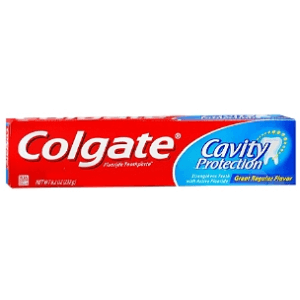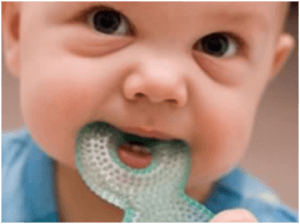Fit Mom Tip- Dental Care: Your Child and You
By: Katie Morrow (Soon-to-be RDH)
Everyone wants their kids to have healthy teeth, but what exactly do you do to make that happen?
The following are tips and tricks for you, the parent, to help your kids have that bright healthy smile all the way till they are grown!
Nutrition
As we all know, cavities or dental caries are caused by an excessive amount of sugar in the diet. The crazy thing is that sugar is found in almost every food! It takes quite a bit of time to find those foods that you and your child will like that do not contain sugar.

So why is sugar bad for teeth and how does it cause caries?
Sugar is broken down by a particular type bacteria in the mouth; streptococcus mutans. This is the bacteria that love to eat sugar, and more importantly causes tooth decay. After eating or drinking something sugary, the s. mutans has a feast and replicates and then creates an acidic environment which breakdowns enamel and demineralizes tooth structure. This demineralization allows more bacteria in and decay is now present and a cavity or carious lesion has been created.
Typical foods that your child may eat or drink that contain sugar are; juice, milk, sugary drinks, breastmilk, cereals and candies. Juice should be 100% juice with no added sugars and should ONLY be taken at meal times. This will decrease exposure to sugars. Whole fruits and vegetables are preferred and encouraged. These may be pureed if needed.
Avoid putting the infant to bed with a bottle with anything other than water. Bacteria loves dark, wet environments and nighttime is their favorite breeding ground.
There is an online resource tool that can be used to find alternative drinks for children: betterbeveragefinder.org.
There is a great new product out on the market called Xylitol. Xylitol comes in many forms; wipes, gum, mints, granulated sugar, sprays and much more. Xylitol is a sugar alcohol, that not only has a low glycemic index but has been PROVEN to PREVENT cavities! Xylitol works to suppress the bad bacteria (strep mutans) to actually prevent cavities. And it’s an alternative sugar, so there is no acidic environment created. It’s a win-win with Xylitol.
Habits
We all know that children mimic their parents, so setting a good example of daily oral care is necessary. 75% of American adults have some form of periodontitis (a disease that is preventable, and is defined as bone loss and tooth loss), yet this can be prevented by good habits, nutrition and home care.

For infants before the first tooth erupts, their mouths should be wiped gently with a warm washcloth damped with water. Tooth formation begins in utero at 6 weeks!!! Most women don’t even know that they are pregnant at 6 weeks, let alone know that that tiny baby inside them has teeth forming. Wiping the gum tissue in the oral cavity reduces the buildup of sugar. Although the teeth have not erupted at this point, a sugary, acidic environment can cause cavities to the teeth underneath the gums.
When the first tooth erupts and until 2 years of age, teeth should be cleaned with a children’s toothbrush and water. At 2 years old, a tiny smear of children’s toothpaste can be placed on the bristles and a parent should brush the child’s teeth. Toothbrushes, for parents and children, need to be replaced every 3 months due to frayed bristles or sooner if they have had a cold or illness. Children should be taught a small circular motion and gently concentrating on the gum line until seven years of age.
As we get older, our manual dexterity improves and short vibratory strokes aimed at the gum line are the most recommended toothbrushing technique. Flossing, everyone’s favorite activity, is recommended daily to remove bacteria between teeth to reduce risk of cavities and periodontal disease. Floss should wrap around tooth making a “C” shape to ensure that all bacteria caught between teeth is removed.
Electric toothbrushes are great!! They come in many different shapes and sizes and prices as well. I will not endorse a particular brand, but electric toothbrushes have been proven to remove 90% more plaque (bacteria).
Fluoride
There has been some controversy in the past about the safety of fluoride. Fluoride in the recommended amounts is safe for use. The Center for Disease Control has called community water fluoridation as one of the top ten public health achievements of the 20th century. Fluorosis can occur if too much fluoride is exposed to teeth during development, mostly during the 1-4yrs of age. Fluorosis is a cosmetic issue, and not a disease, marked by white spots on teeth that have been over mineralized and is non-damaging to teeth. This typically occurs by ingesting too much fluoride. The most common cause of this, is children consuming too much toothpaste or eating toothpaste straight from the tube. A caregiver should supervise toothbrushing until seven years of age, and minimal amounts of toothpaste should be used.
Fluoride works to remineralize teeth and prevent cavities by strengthening enamel. It also makes the tooth resistant to the acidic environment of sugars.

Studies have shown that water fluoridation reduces the need for restorative dentistry, tooth loss, and missed time at work or school. Long-term use of fluoride in children can reduce the cost of oral health care by as much as 50%.
Fluoride is found in several different kinds of foods (it’s naturally occurring in some vegetables, milk, juices, soft drinks, raisins, tea and cereal) and in community water systems. Caries is the most common childhood disease, and for developing teeth it is imperative to have the optimal amounts of fluoride for the prevention of caries.
The recommended optimal level of community water fluoridation is 0.7mg/L. If your local water system is below this level, supplemental fluoride is needed. You can check your local systems level by visiting: www.apps.nccd.cdc.gov?MWF/Index.asp. Your dentist can prescribe fluoride tablets for your child, if they pose a moderate to severe caries risk. Prenatal fluoride supplements are not recommended.
After six months of age, if your child is taking infant formula and there are no other sources of fluoride in diet, then formula should be constituted with fluoridated water. If there is a chance of fluorosis, then non-fluoridated water should be used.
Teething
Now, every new mother has had some sleepless nights when her child is teething. Teething can make infants fussy, uncomfortable and uncooperative. Ask any mom, and they will all give you a different opinion, method or wives tale. The problem is, no one ever really asks the Dental Hygienist. So, here I am to intervene and give scientific basis for coping with teething pain.
For years, mothers have applied topical anesthetics to help soothe gum tissue pain. These typically contain benzocaine and this is the topical anesthetic that licensed dental professionals apply before giving the actual local anesthetic injection. When I was at my Target store the other day, I was actually shocked that benzocaine could be bought over the counter. I had to take a class and become certified in pain management to apply topical and give local anesthetics.
But, here’s a downside to using benzocaine; potential fatal side effects. Yes, FATAL. I won’t go into the molecular reaction of the drug, but it can cause methemoglobinemia, which is a blood disorder where methemoglobin can not release oxygen in the blood stream and the rest of the body. It is a rare condition, but in a small child can prove to be toxic after only one application. Any medication with –caine ending should be avoided.

The alternatives are gentle massages of gums, which will help soothe pain and encourage tooth eruption. Chilled, but not frozen food and teething rings. Cold washcloths can bring comfort too. Allowing a child to chew on anything too hard can cause trauma to the teeth and potential tooth breakage.
Teething biscuits are NOT a good alternative as they are highly cariogenic (cause cavities). They are full of sugar and carbohydrates and should be avoided.
The Parent
A dental home needs to be established by the age of 1 year old. Most children do not have a dental visit until age three, but the ADHA recommends a visit with in the first 6 months of the first tooth erupting.
Children can get caries from their parents. Vertical transmission is the passing of bacterial species from mother to child; sharing utensils, kissing, cleaning a pacifier with parents mouth, testing food, pre-chewing food. A child’s immune system isn’t as developed as an adult’s, therefore the streptococcus mutans bacteria in the parents mouth can create cavities in the child’s mouth.
Non-nutritive sucking on a pacifier, thumb or finger past the first year needs to be discouraged and an orthodontic pacifier is recommended to prevent malalignment of teeth. Ask your dentist or hygienist about obtaining one of these.
Children need help with toothbrushing and when there is tooth-to-tooth contact, flossing should be a habit.
Katie Morrow is a finishing her degree at the University of Oklahoma College of Dentistry, studying dental hygiene. If you have any questions, she can be reached at: Kathleen-morrow@ouhsc.edu.
References:
- Dimensions of Dental Hygiene. February 2013. Volume 11, Number 2.
- Dimensions of Dental Hygiene. October 2012. Volume 10, Number 10.
Other fit mom questions? As the BEST network of fit moms worldwide, we’re here to help! Email us at info@beyondfitphysiques.com and we’ll get an expert to answer YOUR questions relating to fitness, nutrition, and all things MOTHERHOOD! 🙂
Like this post? Spread the word by clicking SHARE below!